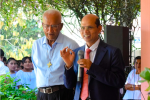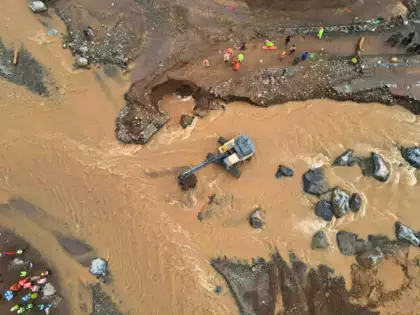By M L Satyan
Coimbatore, Aug 11, 2024: Natural calamities and disasters have been part of human history and these things occur in every country. India has witnessed many disasters like tsunami, cyclones of different types, floods, earthquakes and landslides.
The recent disaster is the landslide and flood in Wayanad, Kerala. This indeed provoked my thoughts.
Soon after every disaster, blame-game and mudslinging are witnessed in political sector. Regarding Wayanad, the Home Minister announced in the Parliament that the State government of Kerala was given advance warning. But the Chief Minister of Kerala denied saying that no timely warning was given by the federal government. This is one blame-game. One MP of the ruling BJP spoke vigorously in the Parliament that the Wayanad MP never raised issues about the disaster-prone areas in Wayanad. This is another blame-game.
Many social activists have come out in public with another blame-game saying that innumerable encroachments, construction of illegal buildings and de-forestation have been on the increase with the blessings and the patronage of politicians and some religious organizations.
Scientific studies and data have shown that Wayanad has always been a landslide-prone area. Mining, de-forestation and constructions are strictly prohibited in this area. Yet, such prohibition has been violated and ignored purposely. In reality, this is an “unnatural disaster” and “human made”. Why? Today we, human beings, plunder nature and natural resources for our selfish enjoyment. This paves way for a disaster.
The basic human NEED can always be met. But our GREED can never be met. Unfortunately, we are submerged in the culture of consumerism that is widespread. We have learnt to consume as much as we can because of our greed. Our consumption is more but our production is less.
People today are willing to do any type of crime – smuggling, robbery, corruption, drug/substance abuse, rape, killing, communal violence and illegal activities etc. just for the sake of money leading to selfish enjoyment. Do such people have any conscience? Yes, they do, but they bury their conscience and keep selfish pleasure as their only target. Mahatma Gandhiji called this crime as “Pleasure without conscience.”
Nature is a God-given gift to us. We, human beings, are only the custodians of nature and natural wealth. We must learn to respect mother earth and save the natural resources. We need to understand that our ancestors used the natural resources sparingly, keeping the welfare of the future generation in mind.
Sadly, today we try to misuse natural resources for our selfish enjoyment unmindful of the future generation. If we continue to over-consume the natural resources, then, our children and grandchildren will have nothing to enjoy. Why are we voluntarily inviting such an unpleasant and unjust situation?
In India there is a strong nexus of politicians-rich people-bureaucracy-police-criminals-religious leaders. They are inter-dependent. They work together, involve in corrupt practices together, share the profit together and safeguard themselves from the law together. They instigate violence, riots, strikes, dharna, killing, destruction of public properties and become responsible for human-made disasters. The consequence of such incidences is the untimely death of innocent people.
We, human beings, have been boasting of our science, technology, military and weapon power. Every country has been spending enormous amount of money for procuring arms, weapons and nuclear power. Our human pride, our imagined self-importance, status and money power, the delusion that we have some privileged position in the universe now is being challenged by a natural or unnatural disaster.
Wayback in 2015 in his encyclical named Laudato Si, Pope Francis wrote, “Mother earth now cries out to us because of the harm we have inflicted on her by our irresponsible use and abuse of the goods with which God has endowed her. We have come to see ourselves as her lords and masters, entitled to plunder her at will.”
“The violence present in our hearts, wounded by sin, is also reflected in the symptoms of sickness evident in the soil, in the water, in the air and in all forms of life. This is why the earth herself, burdened and laid waste, is among the most abandoned and maltreated.”
“The urgent challenge to protect our common home includes a concern to bring the whole human family together to seek a sustainable and integral development, for we know that things can change. I urgently appeal, then, for a new dialogue about how we are shaping the future of our planet. We need a conversation which includes everyone, since the environmental challenge we are undergoing, and its human roots, concern and affect us all.”
“The worldwide ecological movement has already made considerable progress and led to the establishment of numerous organizations committed to raising awareness of these challenges. Regrettably, many efforts to seek concrete solutions to the environmental crisis have proved ineffective, not only because of powerful opposition but also because of a more general lack of interest.”
The Pope highlighted burning issues like pollution, water, biodiversity, quality of human life, breakdown of society and global inequality. He focussed on an integral ecology. This is what our rishis, sages and saints called as “Vasudhaiva Kutumbakam” (the universe is a joint-family). They always invoked, “Loka Samastha, Sukhino Bhavanthu” (let everyone in the universe live happily).
As usual, soon after the landslide disaster in Wayanad, relief works are undertaken by government and non-government organizations. Fund-collection has started by government and non-government organizations and religious groups. New housing and other rehabilitation schemes are announced. Many government and church-based agencies are taking credit for the relief and rehabilitation works undertaken by them. All these are okay.
At this juncture we need to raise certain basic questions for our introspection:
• Are the political leaders in India, concerned about the real causes of this disaster?
• Is there any political Will to stop the environmental degradation?
• Has the Indian Catholic Church really understood the encyclical Laudato Si and taken the message forward? If so, to what extent?
• The local church in Wayanad and Kerala was quite aware of environmental degradation in Wayanad. In that case, did the church groups undertake concrete activities to preserve and protect the environment?
• Are the church groups part of encroachments and illegal constructions in Wayanad area?
• Can the church confine itself only to relief works just to earn a name?
• When shall the government and non-government organizations and church groups realise that prevention is better than cure?












The massive landslide that hit Vellarimala Hills in Wayanad district, Kerala, on 30 July 2024, completely wiped out Mundakkai and Chooralmala villages of Meppadi Panchayat. Dr. K. Soman, former Head of Resource Analysis Division, National Centre for Earth Science Studies (NCESS), explained to ‘The News Minute’ as to why this landslide occurred. According to him, geological factors and unscientific land use patterns of the hilly terrain are the root causes of this very unfortunate incident.
Dr Soman said that the landslide took place due to a combination of factors (1) the slope of the Vellarimala Hills, (2) soil thickness (3) nature of the soil & rocks and (4) rainfall.
Another cause could be the loose subsoil. Dr Soman opined that the Wayanad landslide can be attributed to fractured rocks. Fracturing of rocks is a natural geological phenomenon by which they are divided into two or more pieces by joints or faults. The landslide in Vellarimala Hills descended through the middle part of the two high ridges. In geological terms this is called ‘saddle’ a phenomenon which is either due to fracturing or erosion. Saddles formed by erosion usually occur in limestone, which is not the instant case. The one in Vellarimala was caused by fracturing, Dr Soman reiterated.
He added when water continuously accumulates in the faults of fractured rocks, the soil reaches saturation, and the water bursts forth, taking with it soil, rocks, and vegetation. At Vellarimala, heavy rainfall within a short span of time caused the water from the rock crevices gush down the mountain slopes. The Vellarimala landslide originated at 2,000 metres above sea level. This had a straight fall of 1,000 metres on Chooralmala and on Mundakkai which is 1,100 metres below Vellarimala. The speed of its fall wiped out everything that came in its way – at least 308 lives and 348 houses (Source: ANI news agency).
From Vellarimala Hills, the landslide flowed through Iruvajinzhi river which descends from a height of 1,800 metres. It is along this river the landslide went on a rampage in Mundakai, Chooralmala, Attamala and Noolpuzha. After that it continued for several kilometres along the Chaliyar river.
Dr Soman recalled that between 1984 and 2020 several minor landslides hit Mundakai and Chooralmala. Then why were human settlements allowed in this landslide-prone zone? According to last year’s data released by ISRO’s National Remote Sensing Centre, Kerala has 10 of the 30 most landslide-prone areas in India and Wayanad is the 13th most landslide-prone zone. A study published in 2021 stated that landslide hotspots in Kerala are Idukki, Ernakulam, Kottayam, Wayanad, Kozhikodve and Malappuram districts. It has been seen that 59% of the landslides in Kerala have taken place in agricultural areas. A 2022 study says that between 1950 and 2018, 62% of the forest covers in Wayanad hill disappeared. Cultivation has increased by a whopping 1800% in that place. This means unscientific land use patterns (cutting down of the forest to make way for farming) is going on unabated. Not only geological reasons, reckless felling of trees, cutting of hills for farming, filling of lakes and wetlands are also believed to be the prime reasons behind this destruction.
“Water has memory, it remembers its course, even centuries after it’s diverted. It’s dangerous to attempt to trick nature by occupying the path of a river,” Dr Soman said.
Let’s recall a few devastating incidents in hilly regions: (1) The 12 November 2023 collapse of a section of the Silkyara Bend–Barkot tunnel in Uttarakhand (2) The recent torrential rains and landslides in Sikkim and Kalimpong causing cave-in on the National Highway 10 (NH-10) and its closure; further damage to it under the impact of falling rubble and boulders. (3) The collapse of a 4-storey vegetable market and it being washed away after heavy rainfall in the raging Parvati River in Himachal Pradesh on 1st August 2024. The chain of these incidents and the latest devastation in Wayanad is a stark reminder of humans ignoring the topography of hilly areas and playing with nature in the name of `development’, of course at a huge price! Does Pope Francis’ encyclical `Laudato Si’ ring a bell?
Regarding the debate on early warning of landslide, a meteorological expert said that presently there is no technology which can give advance warning of a landslide. This expertise is being worked upon by the Geological Survey of India and it will take at least five years time to make it fool-proof.